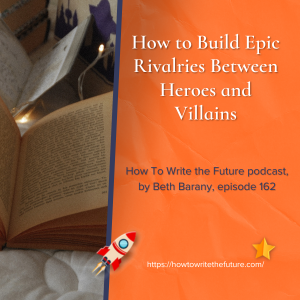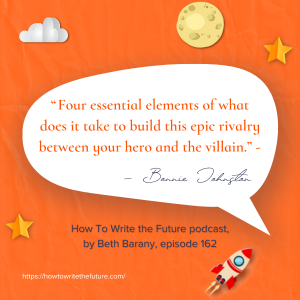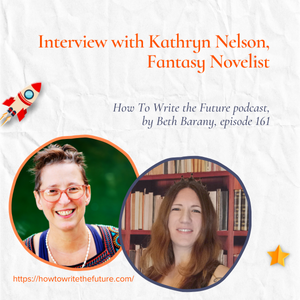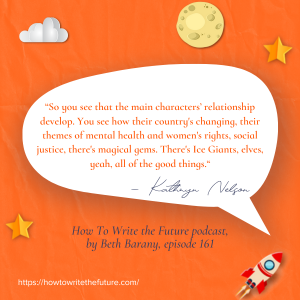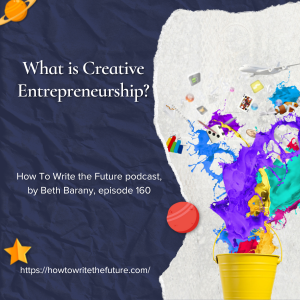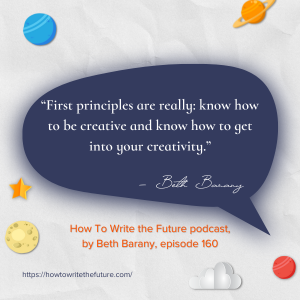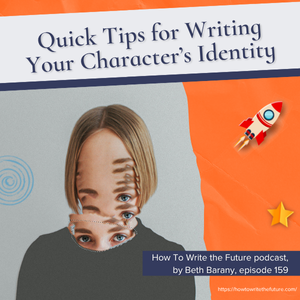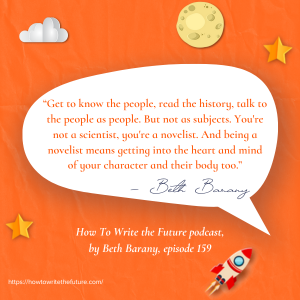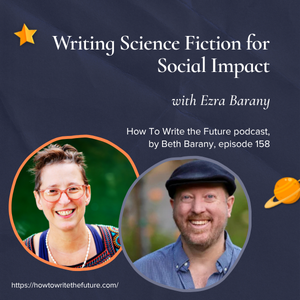Beth Barany's Blog, page 5
July 21, 2025
How to Build Epic Rivalries Between Heroes and Villains
How to Build Epic Rivalries Between Heroes and Villains – How To Write the Future podcast, episoed 162
***
“ Four essential elements of what does it take to build this epic rivalry between your hero and the villain.” – Said by Beth Barany, quoting Bonnie Johnston
Would you like to know how to build epic rivalries between heroes and villains? In this How To Write the Future podcast episode, host Beth Barany reads an article written by writing mentor and award-winning author Bonnie Johnston, in which she shares an in-depth breakdown of the four essential elements of epic rivalries, with step-by-step worksheets, available by signing up to Bonnie’s “Arch Enemies” class
Platforms the podcast is available on: Apple Podcasts | Buzzsprout | Spotify | Amazon Music| YouTube
RESOURCESSupport our work for creatives! Buy me a coffee: https://ko-fi.com/bethbarany
Read the article: How to Build an Epic Rivalry Between Your Hero and Your Villain by Bonnie Johnston
Epic rivalries make for memorable stories — the kinds of stories that are worth re-reading so we can immerse ourselves in the emotional intensity of the hero’s multi-layered relationship with the villain.Get the course “Arch-Enemies” here: **https://bethbarany.com/archenemies [AFF link]**GET HELP WITH YOUR WORLD BUILDING – START HERE
Free World Building Workbook for Fiction Writers: https://writersfunzone.com/blog/world-building-resources/
Sign up for the 30-minute Story Success Clinic with Beth Barany: https://writersfunzone.com/blog/story-success-clinic/
Get support for your fiction writing by a novelist and writing teacher and coach. Schedule an exploratory call here and see if Beth can support you today: https://writersfunzone.com/blog/discovery-call/
About the How To Write the Future podcastThe How To Write The Future podcast is for science fiction and fantasy writers who want to write positive futures and successfully bring those stories out into the marketplace. Hosted by Beth Barany, science fiction novelist and creativity coach for writers. We cover tips for fiction writers.This podcast is for readers too if you’re at all curious about the future of humanity.
This podcast is for you if you have questions like:
– How do I create a believable world for my science fiction story?
– How do I figure out what’s not working if my story feels flat?
– How do I make my story more interesting and alive?
This podcast is for readers, too, if you’re at all curious about the future of humanity.
ABOUT BONNIE JOHNSTONBonnie Johnston is a writing mentor and award-winning author with a passion for teaching fiction writers how to increase the emotional impact of their stories to turn readers into fans.
She blogs at Write Smarter, Not Harder, where you can download her free ebook, Editing for Story.
She’s also the author of The 30 Day Novel Workbook and The Writer’s Guide to Getting Organized.
Transcript for episode 162 How to build epic rivalries between heroes and villains Introduction and OverviewHey everyone. Beth Barany here with How to Write the Future Podcast, Tips for Writers, and today I have a special share for you. Today, I am going to share with you a friend and colleague’s wonderful course and material about how to build epic rivalries between your hero and your villain.
Essentially, we are going to look at four main points- four essential elements of what does it take to build this epic rivalry between your hero and the villain. We’re gonna look at chemistry, the dark push pull dynamic that gets under both characters’ skin. We’re gonna look at the psychological opposition, how the characters should fundamentally frustrate each other through opposing traits. And we’re gonna look at the point of connection. That’s number three, showing how they could have been allies in different circumstances. And lastly, number four, we’re gonna look at the resonant relationship dynamics, how their relationship dynamic is somehow familiar to real life relationship patterns.
The benefit to you as the writer and actually the ultimate benefit to your reader is when you combine these four layers the conflicts between the hero and the villain become more emotional, meaningful, and can be incredible reveals of character. By the time we’re done with this podcast today, I hope you will have some real takeaways that you can design really dynamic and compelling rivalries between your hero and your villain.
[01:50] Introducing Bonnie JohnstonAll right, so today I’m gonna read this article that Bonnie wrote for us about her class. And, so to start off, I’m just gonna tell you a little bit about the teacher and the author of this material, Bonnie Johnston. Bonnie Johnston is a writing mentor and award-winning author with a passion for teaching fiction writers how to increase the emotional impact of their stories to turn readers into fans.
She blogs at Write Smarter Not Harder, where you can download her free book, “Editing for Story”. And she’s also the author of the 30 Day Novel Workbook, The 30 Day Romance Novel Workbook, and The Writer’s Guide to Getting Organized.
Alright, here we go.
[02:35] The Importance of Epic RivalriesDeepen characterization, intensify conflicts, and write stories readers crave. JK Rowling did it. Victor Hugo did it. Sir Arthur Conan Doyle did it. It’s one of the reasons that all three of these authors were massively successful.
Rowling, Hugo, and Doyle created epic rivalries between their heroes and their villains.
Deep multi-layered relationships that locked good guys and bad guys together in high stakes conflicts that couldn’t be easily resolved. Not only do these rivalries generate compelling conflicts, powerful enough to drive big stories and big series, they also take the reader on a deep dive into the psychology of both hero and villain.
[03:27] Epic rivalryWe get to know Harry Potter better through Harry’s struggle to understand how Voldemort became an evil wizard. We love Sherlock Holmes more when we see him resist the temptation to join Moriarty in using his genius for personal gain. And our hearts ache both for Valjean and Javert when we realize they’ve been set at each other’s throats by the tragic social inequities that shaped their lives.
Epic rivalries make for memorable stories, the kinds of stories that are worth rereading so we can immerse ourselves in the emotional intensity of the hero’s multilayered relationship with the villain. In other words, what lies between them is complicated and we love it.
[04:16] Your story’s epic rivalryHow do you create this kind of relationship between your hero and your villain?
You already know that you need to give them mutually exclusive goals to make sure that they have a compelling reason to oppose each other. You might assume that you need to tie your hero and your villain together closely through their backstory. But while that can be a great foundation for the hero villain relationship, Voldemort’s attack on the infant Harry and his parents is at the heart of Harry’s saga, a childhood connection is not essential. Batman didn’t know the Joker before he started committing crimes, and Holmes didn’t know Moriarty before he became a criminal mastermind either.
[5:00] Essential elements in creating an epic rivalryWhat are the essential elements in creating an epic rivalry?
[05:07] Four Essential Elements of Epic RivalriesFirst, you need to create chemistry between your hero and villain.
Their relationship needs to have the same kind of push and pull that the hero and heroine of a romance have albeit in a much darker way. When your villain calls your hero to taunt him, your hero isn’t just staying on the line because he is hoping for a clue to what the villain has done, he is also continuing the conversation because the villain has gotten under his skin.The conflict they’re engaged in is intense because they’re both viewing it through their deeply personal connection.
Second, you need to add a layer of psychological opposition to their relationship. Something in the psychology of each that is fundamentally frustrating to the other. The most common way to do that is to make them opposites in some way, emotionally, ideologically, or in terms of their abilities and skills. But it’s not the only way.
Third, you need to give them a point of connection. Some way in which they understand each other deeply and perhaps even agree with each other. Some of the greatest epic rivalries are ones where you can see how in different circumstances the hero and the villain could have been friends or lovers or teammates.
If you’re creating a rivalry where you want the reader to root for the villain to be redeemed by the hero, that point of connection becomes incredibly important. That point of connection serves as a tool that the hero can use to bring the villain over to the side of good.
Fourth, you can add yet another layer to the hero villain relationship with what I call resonant relationship dynamics.
Dynamics we see all the time in our real life relationships that are separate from the personality dynamic.
For example, your villain might treat your hero like an annoying little brother, triggering your hero’s childish or bratty tendencies, even if your hero never had an older sibling during their own childhood. Or maybe your hero sees himself in the villain, recognizing he’s one misstep away from becoming just like the villain. Or maybe your villain acts as your hero’s conscience, giving your hero exactly the advice he needs to hear, clearly identifying your hero’s flaws and mistakes with brutal honesty. This one’s my favorite.
Four layers of epic rivalry.
When your hero’s relationship with your villain contains these four layers: chemistry, psychological opposition, a point of connection, and a dynamic that resonates for readers– every conflict in your story becomes meaningful, more emotionally charged, and more likely to trigger character revelations.
[07:54] Deep Dive into Bonnie’s CourseIf you are interested in learning more about mastering the art of creating a memorable epic rivalry for your characters, please do check out her course “Arch Enemies”, and that link will be connected to this podcast, whether it’s in the show notes, below the video or in the article that we post on our blog.
In this way in her course “Arch Enemies”, you will not only get an in-depth breakdown of these four layers with step by step worksheets, you’ll also discover the number one must-have trait of villains that readers love to hate. Also, the six characteristics of truly terrifying villains; the three types of stakes you must establish for your hero and stakes are very important; 10 tricks for creating powerful chemistry between your hero and villain; and 12 resonant relationship dynamics that you can use to intensify your hero’s internal conflict. So be sure to check out this class by Bonnie Johnston and dive deeper and master the epic rivalry of your characters at the link that will be in the show notes.
And I’ll also put the link on the screen here. And yes, this is an affiliate link.
[09:16] Conclusion and Contact InformationI hope you like this episode on the four layers of building your epic rivalry by Bonnie Johnston. If you have any questions about it, let me know. You can also connect with Bonnie directly via her website, Write Smarter Not Harder. Uh, That’s it for this week, everyone.
Write long and prosper.
That’s a wrap.
Loved this episode? Leave us a review and rating here: https://www.buzzsprout.com/2012061
Need instructions on how to leave a review? Go here.
***Support our work for creatives: leave a tip: https://ko-fi.com/bethbarany
***
ABOUT BETH BARANYBeth Barany teaches science fiction and fantasy novelists how to write, edit, and publish their books as a coach, teacher, consultant, and developmental editor. She’s an award-winning fantasy and science fiction novelist and runs the podcast, “How To Write The Future.”
Learn more about Beth Barany at these sites:
Author site / Coaching site / School of Fiction / Writer’s Fun Zone blog
CONNECTContact Beth: https://writersfunzone.com/blog/podcast/#tve-jump-185b4422580
Email: beth@bethbarany.com
LinkedIn:https://www.linkedin.com/in/bethbarany/
IG: https://www.instagram.com/bethbarany/
TT: https://www.tiktok.com/@bethbarany/
FB: https://www.facebook.com/bethbarany
X: https://twitter.com/BethBarany
CREDITSEDITED WITH DESCRIPT: https://www.descript.com?lmref=_w1WCA (Refer-a-Friend link)MUSIC CREDITS : Music from Uppbeat (free for Creators!): https://uppbeat.io/t/soundroll/fuzz-buzz License code: UMMKDRL02DFGKJ0L. “Fuzz buzz” by Soundroll. Commercial license: https://musicvine.com/track/soundroll/fuzz-buzz.DISTRIBUTED BY BUZZSPROUT: https://www.buzzsprout.com/?referrer_id=1994465 (Refer-a-Friend link)SHOW PRODUCTION BY Beth BaranySHOW CO-PRODUCTION + NOTES by Kerry-Ann McDadec. 2025 BETH BARANY
For more “How To Write the Future” episodes, go here.
If you’d like to invite Beth onto your podcast, drop her a note here.
 Like the work we do? Tip us! https://ko-fi.com/bethbarany
Like the work we do? Tip us! https://ko-fi.com/bethbarany
The post How to Build Epic Rivalries Between Heroes and Villains appeared first on Writer's Fun Zone.
July 18, 2025
When Can I Use Quotes in My Book? by Kelley Way
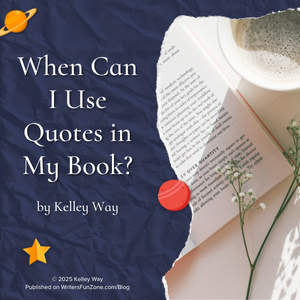 Let’s welcome back monthly columnist Kelley Way as she shares with us “When Can I Use Quotes in My Book?” Enjoy!
Let’s welcome back monthly columnist Kelley Way as she shares with us “When Can I Use Quotes in My Book?” Enjoy!
***
Let’s face it, we all love using quotes in our writing.
Not only does it save us the trouble of coming up with our own words, but it’s also fun to insert some famous lines, and sometimes there’s just no way to improve on greatness.
However, those pesky copyright laws make quoting problematic, and we don’t want to get in trouble for using someone else’s words.
So, when is it okay to use quotes in your book?
When You get PermissionPermission is the gold standard.
If you get permission from the copyright owner, you have a green light to proceed.
However, be aware that getting permission can be tricky — not all copyright owners are easy to track down, and it’s not uncommon to get no response from your request.
They may also reject your request, or demand a fee that’s higher than you’re willing or able to pay.
When the Quote is Not CopyrightedYou can’t have copyright infringement when there’s no copyright.
So if the work you’re quoting from is not copyrighted, there’s no issue.
In the U.S., anything published before 1930 is in the public domain, meaning the copyright has expired and it’s free for anyone to use.
So go ahead and quote Shakespeare in front of every chapter, you won’t get in trouble.
When the Quote is De MinimisIf the quote is a tiny fraction of a bigger work, the courts may declare it “de minimis,” meaning it’s such a small piece the use can’t harm the copyright owner, and therefore it’s not infringing.
But be aware that your definition of small may not align with the copyright owner’s definition, so it’s a shaky foundation to rest your case on.
When It’s Fair UseFair use is an exception to copyright infringement rules.
The idea is that your use serves a public benefit that outweighs the harm to the copyright owner, so there’s no infringement.
But fair use is probably the trickiest of all these options, because there are no hard rules for when something is or is not fair use.
There is a test that can serve as a guideline, but the court’s decision is often subjective.
So fair use should be a last resort rather than a first option.
Conclusion and About the AuthorAs much as we all love quotes, using them is much like walking through a minefield.
You’ll need to decide if you want the quote badly enough to make the trek.
If you would like help determining how risky it might be to use quotes in your next book, you’re welcome to reach out to me at kaway@kawaylaw.com.
***
Want to read more articles like this one Writer’s Fun Zone? Subscribe here.
***
ABOUT THE AUTHORKelley Way was born and raised in Walnut Creek, California. She graduated from UC Davis with a B.A. in English, followed by a Juris Doctorate. Kelley is a member of the California Bar, and an aspiring writer of young adult fantasy novels. More information at kawaylaw.com.
The post When Can I Use Quotes in My Book? by Kelley Way appeared first on Writer's Fun Zone.
July 14, 2025
Interview with Kathryn Nelson, Fantasy Novelist
Interview with Kathryn Nelson, Fantasy Novelist – How To Write the Future podcast, episode 161
***
“So you see that the main characters’ relationship develop. You see how their country’s changing, their themes of mental health and women’s rights, social justice, there’s magical gems. There’s Ice Giants, elves, yeah, all of the good things.“ – Kathryn Nelson
From Ice-giants, fantasy worlds, to the power of fantasy in addressing real-life issues. In this How To Write the Future episode, host Beth Barany talks to fellow fantasy Novelist Kathryn Nelson, where they discuss writing about matriarchal societies within their novels, including why there is a need for strong character role models. Plus, Beth and Kathryn explore positive futures through storytelling.
Platforms the podcast is available on: Apple Podcasts | Buzzsprout | Spotify | Amazon Music| YouTube
RESOURCESFOR CREATIVE WRITING PROFESSIONALS – BUILD YOUR BUSINESS SERVING WRITERS
Sign up to be notified when our training opens and get a short Creative Business Style Quiz to help you create success.
https://bethbarany.com/apprenticeship/
Support our work for creatives!
Buy me a coffee: https://ko-fi.com/bethbarany
GET HELP WITH YOUR WORLD BUILDING – START HERE
Free World Building Workbook for Fiction Writers: https://writersfunzone.com/blog/world-building-resources/
GET SOME FREE WRITING COACHING LIVE ON THE PODCAST
Sign up for the 30-minute Story Success Clinic with Beth Barany: https://writersfunzone.com/blog/story-success-clinic/
GET SUPPORT FOR YOUR FICTION WRITING BY A NOVELIST AND WRITING TEACHER AND COACH
Schedule an exploratory call here and see if Beth can support you today: https://writersfunzone.com/blog/discovery-call/
About the How To Write the Future podcastThe How To Write The Future podcast is for science fiction and fantasy writers who want to write positive futures and successfully bring those stories out into the marketplace. Hosted by Beth Barany, science fiction novelist and creativity coach for writers. We cover tips for fiction writers.This podcast is for readers too if you’re at all curious about the future of humanity.
This podcast is for you if you have questions like:
– How do I create a believable world for my science fiction story?
– How do I figure out what’s not working if my story feels flat?
– How do I make my story more interesting and alive?
This podcast is for readers, too, if you’re at all curious about the future of humanity.
ABOUT KATHRYN NELSON Kathryn Nelson is a writer of honest fantasy, genuine heroines, and wellness wisdom. She lives in Northern Ireland with her husband and Irish red setter and spends her time sitting at a sunny desk overlooking her wild garden when writing every day. She enjoys long walks in the hills and by the coast, whilst conjuring dragons from the sky, questing for selkie in the sea, and conversing with fairies in the woods.Website: https://www.kathrynnelsonwriter.com/
Facebook: http://www.facebook.com/KathrynNelsonWriterFB
Instagram: http://www.instagram.com/kathrynnelsonwriter
TikTok: http://www.tiktok.com/@kathrynnelsonwriter
YouTube: http://www.youtube.com/@kathrynnelsonwriter
Newsletter Sign-up for free ebook: https://www.kathrynnelsonwriter.com/gifts
Transcript for episode 161 Interview with Kathryn Nelson, Fantasy NovelistIntroductionBETH BARANY: Hi everyone. Welcome or welcome back to How to Write the Future podcast. I’m your host, Beth Barany, and I am a science fiction and fantasy writer, and, writing coach, teacher, editor, and filmmaker.
I run this podcast because I’m very interested in talking to authors and other futurists and other people who care about the future because I believe with story, with our stories, we can help people reshape how they think of what could be possible. And my big focus is on helping us be new humans. How can we change the way we interact with others and also with ourself?
And my focus is on positive, optimistic futures because why not? Our creativity is incredible. Why not use it to create worlds and relationships that would benefit all of us, everybody and all living creatures on this planet.
[00:59] Guest Introduction: Kathryn NelsonBETH BARANY: So I’m very excited today to bring to you a special guest, an author, a fantasy novelist, Kathryn Nelson.
Kathryn, welcome. So glad you could be here.
KATHRYN NELSON: Lovely. Thank you for having me.
BETH BARANY: And I understand you’re calling in from Northern Ireland, is that right?
KATHRYN NELSON: Yeah, that’s right. It’s quite warm over here actually at the moment. Not too bad.
BETH BARANY: I’m in the foggy San Francisco Bay area this morning. So with the magic of technology, we can connect in real time. It’s so wonderful.
[01:27] Kathryn’s Background and InspirationsBETH BARANY: So everyone, I’m gonna read to you a little bit about Kathryn so you can get to know her, and then we’re gonna dive into our interview.
So Kathryn Nelson is a writer of honest fantasy, genuine heroines and wellness wisdom. She lives in Northern Ireland with her husband and Irish Red Setter. And spends her time sitting at a sunny desk, overlooking her wild garden when writing every day. She enjoys long walks in the hills and by the coast, whilst conjuring dragons from the sky, questing for selkie in the sea, and conversing with fairies in the woods.
What a beautiful bio. Welcome again, Kathryn. So glad you could be here, and I’m really excited to talk to you about, I know something we have in common with our fiction is featuring strong, interesting women in the leading role.
That’s so wonderful.
KATHRYN NELSON: Yeah, definitely.
BETH BARANY: Yeah. So good. So you obviously bring your Irishness to all that you create. I could just tell from your bio.
[02:29] The Power of Fantasy in Addressing Real IssuesBETH BARANY: So I was wondering if you could answer for us: How can the fantasy genre provide a unique perspective on issues close to home?
KATHRYN NELSON: I think the fantasy genre is really interesting because you can make up these kind of different worlds, and be different magic and different organizations for society and whole new planets. And then you can get this whole different perspective at issues close to home.
So I write about social change and parenting and family stuff, and relationships and it’s set in this fantasy world. And at one point they go and visit the ice giants and their whole society is a matriarchy, so just really interesting what if, what if question, I think. And fantasy and sci-fi as well, are a really good vehicle for those sorts of questions.
BETH BARANY: I totally agree. That’s wonderful. And is it the ice giants that are matriarchal?
KATHRYN NELSON: Yeah. Yeah. They’ve got a matriarchy, but also it’s more of like an anarchy, but like in the best sort of way they’ve put this which is do what you want and you take personal responsibility for your actions. Yeah, some interesting consequences for the story kind of progression.
And then, the main characters come from what was, starts off in the story as like a military tyranny, dictatorship, and then it transitions into a monarchy and then she visits the neighboring country and more a communist style government going on. And then she goes and visits the Ice Giants, and other societies.
How she can then take these lessons back to her country.
BETH BARANY: I really love that. I’m doing something similar in my science fiction space station mystery series, where my main character gets to see different kinds of societies, but I’m doing it one book at a time.
[04:14] Role Models in FictionBETH BARANY: Why in your opinion, do you think we need to see real people navigating, living in these fantasy worlds?
KATHRYN NELSON: I think it’s really important because they’re role models that archetype and they for me, like I find, like I’m influenced by what these characters do in this situation. Okay. I’m going to behave like them and really admire them and what they do. And I just see a lot of not very good role models sometimes in public culture.
Not just books, but culture in general. And I just find it really, part of the reason I like writing is cause sometimes like bad stories are more inspiring for me because I’m like, oh, that’s so annoying.
Like I really wanna retell that story in a better way, where the women’s got more of a voice that is, yeah, just a better role model. It annoys me when women, then are either like really wimpy or they can go for like a week with like no food and no sleep and then be like fight a big battle at the end. It’s like, when I was reading that stuff, as a teenager, I’d be like, oh, I’m not like that. That’s just not realistic.
BETH BARANY: Yeah. Yeah. And then it’s like there’s no way that you could ever aspire to that, because it’s completely unrealistic to how real people operate. Yeah.
KATHRYN NELSON: Yeah, definitely. And, and when you try to learn and like navigate relationships as well. Then there’s examples of bad relationships for the sake of drama or the sake of the story, but they actually mad modeling, really core behavior. And that sets up in your expectations for you. The relationships you have in real life yeah, it’s just, yeah not helpful.
BETH BARANY: Yeah. So you’re really pointing to something that I really, love also about stories is that using your stories to model the best of humanity, even in, inside of a fantastical setting. I love that.
KATHRYN NELSON: Yeah, definitely. And yeah, I don’t like anything too dark, there’s enough dark stuff going on in the world, like there could be a bit of dark, a bit of adventure, a bit of excitement, but yeah, definitely a happy ending. I’ve been reading a lot of cozy fantasy recently, which is just really nice.
Just like people being nice to each other, nice things happening. It’s just really, yeah, nice.
BETH BARANY: I’ve read a few cozy fantasies. I’ve really enjoyed them. I do read a lot of cozy mysteries. My favorite are the cozy mystery fantasies. Putting that all together.
KATHRYN NELSON: Okay.
BETH BARANY: Yeah. Oh, that’s great.
[06:39] Exploring Positive Futures Through StoriesBETH BARANY: And this really segues us to the next question, which is how can fiction that explores solutions inspire a brighter future?
KATHRYN NELSON: I think it’s what we’ve been talking about from the role models, about, all of those what if questions.
I wrote a series of short stories a while ago, not published, but just as like thought exercises about kind of environmental problems and visioning, what would those solutions look like?
So about growing food in cities and rewilding rivers and, what would neighborhoods, at the time there was talk about, oh, you can’t do this and you’ve gotta do that and all like real negative stuff or doom and gloom stuff. And I was like, let’s think about what this could look like and try and do it in a really positive way because what you’re imagining is what’s gonna happen.
BETH BARANY: I so agree, you’re reminding me of this movement that people are creating art in called Thrutopia. Are you familiar with Thrutopia?
KATHRYN NELSON: Oh, I heard the phrase the other day.
BETH BARANY: It was coined by, I believe, an activist who, and then I learned it from Amanda Scott, who’s a writer, a British writer who then taught a wonderful class that I was a part of a few years ago. Where writers are and other artists are using their creativity and imagination to write stories about, what if positive environmental change, and how do we not utopia, which is when everything is all worked out, but how do we get there?
How do we go through the present moment into the kind of world we wanna create? So how do people come and work together? How do collectives make decisions to benefit the community?
I watch a lot of YouTube, so I watch videos about, oh look, they took a plain golf course, and they turned it, they rewild it. Oh, look how they did that, and look what happened.
So showing positive stories and how the collective comes together to make the decision, and then the positive impact that has and how that’s happening now, or it could happen tomorrow. And so showing us the steps that we can take to make these bigger changes that affect the communities, the communities that we live in.
Yeah.
KATHRYN NELSON: Yeah. It’s amazing. Yeah. And amazing how stories can help show, show that way.
BETH BARANY: Yeah. I love it. So those are some short stories that you wrote that you haven’t published yet?
KATHRYN NELSON: Yes, but those sorts of themes weave through my novels as well, you know the talks about city healthcare and like healthier family dynamics and, the main character eventually ends up on like the governing committee in the country. And she’s like the first woman to do that. The female voices up on those higher levels of management, so yeah, those sorts of things that..
BETH BARANY: Oh, that’s wonderful. I really love that. And that brings us to this next question, which is: why is creating healthy role models for women crucial in 2025 and beyond?
We’ll start with where we are right now.
KATHRYN NELSON: I think there can be a lot of negativity, like in the news, social engagement, but I think, it’s just what we’ve been saying isn’t it? About those positive stories, positive role models. Not to like completely ignore the less positive stuff that’s going on, and not to, you know, you’ve got to acknowledge that at the same time, it’s also part of the story, but it’s about, I think it’s, you know, where your, What’s the phrase, where your attention goes is where your energy flows? Is that the phrase? Like that’s you know, what you focus on, what you, what you look at.
I saw your bio. You talk about neuro linguistic programming, like the words that you use and how you, how you talk, that self talk and how you talk to other people. Like it’s all so important. And if you want to go in a more positive direction and see healthier, yeah we need those role models, stories which can help us navigate our journey.
BETH BARANY: That’s beautiful.
[10:35] Kathryn’s Book Series OverviewBETH BARANY: I love seeing your books behind you and I was wondering if you could give us the short, back of the book blurb about your series, about Book one to entice people to check out your books.
KATHRYN NELSON: Yeah. Gems and Giant series. There’s four books in ebook, paperback and audiobook. Siria is married to the high commander, who has taken the thrown away from the king and is holding the country in a grip of military tyranny. And she is kidnapped by the monarchist rebel who’s hoping to turn her to his cause, and they go on an adventure, and so that’s book one.
And then the next books are set all kind of a year apart. So you kind of see the main characters relationship develop, you see how their country’s changing. There’s themes of mental health and women’s rights, social justice. There’s magical gems. There’s Ice Giants, elves, yeah, all of the good things. Book one is free if you sign up for my newsletter. So if you go to my website and sign up for the newsletter, so you can yeah, check it out.
BETH BARANY: Oh, that’s wonderful. And so tell us, your website link.
KATHRYN NELSON: So it’s KathyrnNelsonWriter.com
BETH BARANY: Beautiful. I encourage everyone to check it out. I will definitely check it out.
[11:53] Final Thoughts and Wrap-UpBETH BARANY: And as we wrap up today, is there anything else that you would like to talk about or bring up, or say as we wrap up our interview?
KATHRYN NELSON: No, I think that’s covered everything. It was lovely talking to you. I feel like we’ve got quite a lot in common, and you know, similar themes in our writing.
BETH BARANY: Absolutely.
And I love that you’re dealing with mental health issues. I’m actually working on a TV series that I wanna bring out mental health issues in a way that the group is handling well. So I love that you’re doing that and I presence strong women, as my main characters in all my stories.
‘Cause ‘ cause, role models, we need role models. Yeah. So this is wonderful. I just wanna thank you so much, Kathryn. I hope that this was a good first interview. I know, it’s, we all have to start somewhere, and I definitely would love to hear more about you and your work as it evolves.
So we’ll definitely have to have you back, and, yeah, that’s it. And, just wanna thank you again for being a guest.
KATHRYN NELSON: Thank you so much for having me. I really enjoyed it.
BETH BARANY: That’s so great. Alright everyone, that’s it for this week. Write long and prosper.
Loved this episode? Leave us a review and rating here: https://www.buzzsprout.com/2012061Need instructions on how to leave a review? Go here.
***Support our work for creatives: leave a tip: https://ko-fi.com/bethbarany
***
ABOUT BETH BARANYBeth Barany teaches science fiction and fantasy novelists how to write, edit, and publish their books as a coach, teacher, consultant, and developmental editor. She’s an award-winning fantasy and science fiction novelist and runs the podcast, “How To Write The Future.”
Learn more about Beth Barany at these sites:
Author site / Coaching site / School of Fiction / Writer’s Fun Zone blog
CONNECTContact Beth: https://writersfunzone.com/blog/podcast/#tve-jump-185b4422580
Email: beth@bethbarany.com
LinkedIn:https://www.linkedin.com/in/bethbarany/
IG: https://www.instagram.com/bethbarany/
TT: https://www.tiktok.com/@bethbarany/
FB: https://www.facebook.com/bethbarany
X: https://twitter.com/BethBarany
CREDITSEDITED WITH DESCRIPT: https://www.descript.com?lmref=_w1WCA (Refer-a-Friend link)MUSIC CREDITS : Music from Uppbeat (free for Creators!): https://uppbeat.io/t/soundroll/fuzz-buzz License code: UMMKDRL02DFGKJ0L. “Fuzz buzz” by Soundroll. Commercial license: https://musicvine.com/track/soundroll/fuzz-buzz.DISTRIBUTED BY BUZZSPROUT: https://www.buzzsprout.com/?referrer_id=1994465 (Refer-a-Friend link)SHOW PRODUCTION BY Beth BaranySHOW CO-PRODUCTION + NOTES by Kerry-Ann McDadec 2025 BETH BARANY
For more “How To Write the Future” episodes, go here.
If you’d like to invite Beth onto your podcast, drop her a note here.
 Like the work we do? Tip us! https://ko-fi.com/bethbarany
Like the work we do? Tip us! https://ko-fi.com/bethbarany
The post Interview with Kathryn Nelson, Fantasy Novelist appeared first on Writer's Fun Zone.
July 11, 2025
Habits of Mind: Curiosity by Bailey Lang
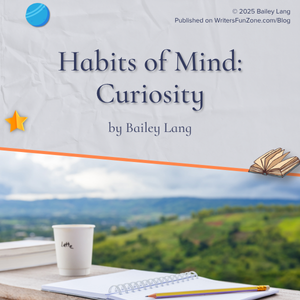 Let’s welcome back Bailey Lang as she shares with us “Habits of Mind: Curiosity.” Enjoy!
Let’s welcome back Bailey Lang as she shares with us “Habits of Mind: Curiosity.” Enjoy!
***
Habits of mind are patterns of thinking that determine the shape and success of our writing practice.
The last post Habits of Mind Overview by Bailey Lang · Writer’s Fun Zone, identified eight habits of mind that matter for writers, and today, we are talking about curiosity.
What is Curiosity?The framework for this series of articles defines curiosity as “The desire to know more about the world,” which is a good starting point!
The desire to know more about the world is behind every small child’s eternal question: Why?
Curiosity drives us to lift a rotten log, pause in the hallway to try and overhear what’s going on in that budget meeting, or read a book about the history of salt.
It feels almost silly to point out that curiosity is an essential habit of mind for writers — like, duh, of course it is! — but stay with me.
Right now, it can feel like we have all the tools we need to satisfy our curiosity (“Let me Google this actor, I know him from something else.”)
We’ve gotten used to asking a question, whipping out our phones, and getting an immediate hit of information, which is increasingly likely to be an AI-generated summary.
As writers, we can do better at cultivating curiosity in a way that serves our writing.
How do Writers Cultivate Curiosity?In her fantastic book, Wrede on Writing, Patricia C. Wrede, Wrede on Writing, talks about three types of research writers conduct:
Accidental — “Paying attention to whatever is going on around you because everything is material.”General — “Going looking for things you don’t know that you need to know.”Specific — “What you do in order to find out the things you know you need to know.”These modes of research lend themselves neatly to practical ways of fostering curiosity as a habit of mind.
Accidental research requires cultivating curiosity as part of your daily life.
Anything you encounter could become important for the next story you want to tell.
Getting curious about everything around you — what things look like, sound like, smell like; why people act the way they do — sets you up to be a better observer, deeper thinker, and more interesting storyteller.
General research helps you take your new habit of mind to a more advanced level, encouraging you to explore topics that relate to your writing or that simply strike your fancy.
As someone with curiosity as a core habit of mind, you’ll find interesting ideas lurking in unexpected places.
Reading nonfiction, listening to history podcasts, and watching documentaries will spark interesting story ideas.
Specific research involves a deeper dive into a topic, probably related to the book you’re writing — whether fiction or nonfiction.
Conducting specific research helps you cultivate curiosity by encouraging you to find useful information, evaluate your sources, and think about how you’ll use important details in your writing.
As Wrede puts it, “If I have a character who speaks thieves cant, I reach for my copy of The 1811 Dictionary of the Vulgar Tongue. If my characters are mixing up a potion, I look through my various herbals in search of ingredients…”
Specific research is also how you avoid making silly mistakes, like having a character cross the Golden Gate Bridge in a story set in the 1920s (the Golden Gate Bridge wasn’t open to the public until 1937.)
Curiosity as a habit of mind can become part of your everyday approach to the world and support focused, active inquiry into particular subjects.
The first step to strengthening your curiosity is recognizing its importance and looking for opportunities to indulge in it.
Curiosity-Generating Activities for WritersEngaging curiosity can be as simple as asking, “Why?” more often.
However, I’ve got a few other activities to recommend that lend themselves especially well to curiosity and writing.
The more of these activities you do — and the more often you do them — the more you’ll strengthen curiosity as one of your core habits of mind.
Make a General Curiosity ListSpend five minutes writing out a list of all the things you’re already curious about, whether or not they’re related to any of your current writing projects.
What topics appear on the list?How can you start following your curiosity about some of those topics?Visit the LibraryGo to your local library — in person, if possible! — and wander the nonfiction stacks.
Look at book titles and descriptions until something jumps out at you. If you’re feeling especially brave, grab a book at random!
Check that book out, read it, and write down things that struck you as you read.
This list could include interesting new facts, story ideas, character ideas, and additional questions for future research.
Track Your Accidental CuriosityWrede notes that accidental research is part of how we, as writers, move through the world.
Sometimes, we get so caught up in the day-to-day that we stop paying attention.
Tracking your accidental curiosity is a great way to get back in the groove.
Over the next week, keep a record of all the things you notice that make you curious.
You can write these down in an app or physical notebook — but make an effort to document things.
Did you Google something? Put your question on the list.Did you hear a bird outside your window and wonder what it was? On the list it goes.Did you find yourself wondering why your boss worded an email like that? Make a note.Did you catch yourself thinking about all the what-ifs that might have led you (or someone else’s) down a different path? You guessed it: put it on the list.At the end of the week, take stock of all the things you were curious about.
What questions did you ask?What did you notice?What did you want to know more about?This information will sharpen your sense of curiosity — and may even lead you to your next great story idea.
Reading RecommendationsWrede on Writing (Affiliate link)A Curious Mind: The Secret to a Bigger Life (Affiliate link)Beyond Anxiety: Curiosity, Creativity, and Finding Your Life’s Purpose (Affiliate link)***
About the Author Dr. Bailey Lang is a book coach, writer, and editor. At The Writing Desk, she helps authors build sustainable, enjoyable writing practices that take their books from draft to done. Bailey has a PhD in rhetoric and writing studies and loves geeking out about writing.
Dr. Bailey Lang is a book coach, writer, and editor. At The Writing Desk, she helps authors build sustainable, enjoyable writing practices that take their books from draft to done. Bailey has a PhD in rhetoric and writing studies and loves geeking out about writing.
You can sign up for Bailey’s free newsletter, Word to the Wise, for more writing advice and regular author interviews.
The post Habits of Mind: Curiosity by Bailey Lang appeared first on Writer's Fun Zone.
July 7, 2025
What is Creative Entrepreneurship?
What is Creative Entrepreneurship? – How To Write the Future podcast, episode 160
***
“First principles are really: know how to be creative and know how to get into your creativity.” – Beth Barany
In this How To Write the Future episode, called “What is Creative Entrepreneurship?,” host Beth Barany gets interviewed about defining creative entrepreneurship and explains the importance of prioritizing creativity over business and why she believes being a creative comes first. Plus, she goes in depth on how we can make it work for us as creative individuals.
Platforms the podcast is available on: Apple Podcasts | Buzzsprout | Spotify | Amazon Music| YouTube
RESOURCESFOR CREATIVE WRITING PROFESSIONALS – BUILD YOUR BUSINESS SERVING WRITERS
Sign up to be notified when our training opens and get a short Creative Business Style Quiz to help you create success.
https://bethbarany.com/apprenticeship/
Support our work for creatives!
Buy me a coffee: https://ko-fi.com/bethbarany
GET HELP WITH YOUR WORLD BUILDING – START HERE
Free World Building Workbook for Fiction Writers: https://writersfunzone.com/blog/world-building-resources/
GET SOME FREE WRITING COACHING LIVE ON THE PODCAST
Sign up for the 30-minute Story Success Clinic with Beth Barany: https://writersfunzone.com/blog/story-success-clinic/
GET SUPPORT FOR YOUR FICTION WRITING BY A NOVELIST AND WRITING TEACHER AND COACH
Schedule an exploratory call here and see if Beth can support you today: https://writersfunzone.com/blog/discovery-call/
About the How To Write the Future podcastThe How To Write The Future podcast is for science fiction and fantasy writers who want to write positive futures and successfully bring those stories out into the marketplace. Hosted by Beth Barany, science fiction novelist and creativity coach for writers. We cover tips for fiction writers.This podcast is for readers too if you’re at all curious about the future of humanity.
This podcast is for you if you have questions like:
– How do I create a believable world for my science fiction story?
– How do I figure out what’s not working if my story feels flat?
– How do I make my story more interesting and alive?
This podcast is for readers, too, if you’re at all curious about the future of humanity.
Transcript for episode 160 Writer Business without the OverwhelmIntroduction to Creative EntrepreneurshipEZRA BARANY: So Beth,tell us what is creative entrepreneurship?
BETH BARANY: So yeah, creative entrepreneurship. What is it?
[00:09] Defining Creative EntrepreneurshipBETH BARANY: So a lot of people define creative entrepreneurship in different ways. I guess what’s important here is the way I define it, so I see being a creative entrepreneur is about being a creative first and an entrepreneur second, which is very unusual.
A lot of people don’t think of it that way, and I break it down that way because when we create something like the actual zone of creating, yes, it may have marketing considerations, but the zone, what do people call it? They call it the zone, right? They call it the flow, being in the flow.
And I think when you’re in the flow, you’re not thinking about the past, you’re not thinking about the future. You’re just in the flow.
When you think about marketing your stuff and reaching the marketplace and reaching your fans and reaching new readers as authors, then now you’re starting to think about marketing considerations and it takes you outta the flow.
[00:58] First Principles of Creativity and EntrepreneurshipBETH BARANY: Let’s break it down. I like first principles.
EZRA BARANY: So first principles. Where are the first principles?
BETH BARANY: Yeah. First principles are really, know how to be creative and know how to get into your creativity.
And then when you’re in the entrepreneurship space, now think about, How do you talk about what you’re making? How do you clarify who your audience is? How do you reach your audience? And how do you create a place for them to purchase your material or enjoy your material?
And all of those considerations seem to use a different part of our brain than the creative part. Now, that’s not to say you can’t apply your creativity to all those things.
In fact, that’s what I advocate for. Like the same energy that we use to come up with story ideas and create things, let’s apply that generative and like juicy energy, and focus, often when we’re in creative space, we’re super focused. Let’s apply that to entrepreneurship. I think of being a creative entrepreneur, as being creative first and an entrepreneur second.
So.
EZRA BARANY: Great.
[02:06] Importance of Creative EntrepreneurshipEZRA BARANY: What is the importance for becoming a creative entrepreneur?
BETH BARANY: Sure. It’s definitely an elective choice. For a lot of writers, and I’m gonna just speak of writers ’cause that’s what I know the most. We write to be read. I haven’t met a single writer who writes novels and other short fiction and all those things because they just wanna keep it to themselves. They want someone to read it, even if it’s an intimate group of fellow writers or their family, or a thousand of their closest friends.
You agree with me, you’re a writer.
EZRA BARANY: Yes.
BETH BARANY: You’ve always been driven by having other people appreciate what you’ve created, right? What you’ve written.
EZRA BARANY: Yeah. In fact it’s what keeps me writing is picturing them reading this moment I’m writing about.
BETH BARANY: Yeah. But a lot of people are stopped from getting their work into the marketplace for fear of criticism, for fear of, even I was super afraid when I was publishing my first book, but I also was driven just like you by that desire to be read.
Because I also remembered being a reader, and I’ve been an avid reader since I was a child.
So why is this important? We tend to think that we have to enter the marketplace a certain way. And there’s all these rules and there’s all these ways things have been done. Just like we write stories within a structure of what a story is and within that structure there’s so much freedom. Even within storytelling. So why can’t we enter the marketplace in a way that works for us?
So I think by talking more about creative entrepreneurship, we can talk about how do we make it work for us?
The principles I’m talking about actually doesn’t apply just to being creative people, it applies to anybody. ‘Cause I think, if you wanna be in business and you wanna do it your own way, now you’re applying your creativity, you’re applying choice and decisions, I kind of see it like an alchemy.
You’re basically saying, here’s how I want it to be. Here’s my ingredients. Now how do I cook this up in the way that would fit my taste buds? To just use a cooking metaphor, veering a little away from alchemy. Does that answer the question about why I care about this issue?
Okay, here’s the big soapbox thing.
I believe that the ability to be creative is a human right and something we’re all born with. And bringing our creativity, our wild imaginations into doing business is going to serve not only us as authors, and it maybe you’re a creative writing professional. It’s gonna serve everybody because there’s so many different ways to do it. There’s not one way. So let’s bring the conversation out. Let’s be creative, let’s be playful. I believe we need more examples of that.
There’s not one way to sell your services or sell your books. So let’s play in that space of what else could it be?
Just like we play in the storytelling space of the kinds of characters and the kinds of stories that we wanna write. That’s why.
EZRA BARANY: So let me ask you this.
[05:05] Steps to Become a Creative EntrepreneurEZRA BARANY: What would be the next steps or the first steps for someone to take to become a creative entrepreneur?
BETH BARANY: Yes, very good question. When I work with creative entrepreneurs, and I do, I work with people who wanna be, they wanna be a creative writing professional, like editorial assistant or a virtual assistant to an author or a book coach. Or an editor.
The very first thing that you need to focus on is your skill set in the chosen field, in the way you wanna help people. You need to get good at that. You need to get specialized training or get lots of experience and do everything you can to get lots of, have your training wheels on for a while and then take off your training wheels. And, there are lots of training, different kinds of training programs for these things.
Specifically I know in editing, and being a virtual assistant, and then meet people who are doing what you wanna do or are adjacent to what you wanna do. Like maybe you only know book designers or cover designers. Hang out with them, find out how they do things and just start to network.
So I first get professional training, and or lots of experience, network with people in your adjacent fields.
And then number three is learn some business skills. Learn how to talk about what you do in the marketplace. Learn how to write a short blurb about what you do, and have a professional bio and decide how you wanna market. Build a mailing list. As you get more refined in what your offer is, offer a freebie. And then look for ways to do a one to many. You show up in front of a group of people, whether you do it online, or in person .
And lastly, or also in conjunction, these are all together, there are some order of this, but also not, it depends on your personality. And in fact, entirely depends on your personality, but you wanna learn how to have some kind of offer, whether you wanna offer small group classes or coaching one-on-one or editing one-on-one or working with a lot of clients or maybe just a few clients.
That’s the business model. Who do you serve and how will you earn your money? And at what price point?
So there’s professional development that you need to learn in your skills, but then there’s also business development. I have been doing one form or another of business development training ever since I started my business 19 years ago.
So it really never stops in my opinion, and neither does the skillset training in like being a better writer, being a better editor, better teacher, better coach. Those are the things I mostly focus on.
EZRA BARANY: Let me ask you this.
[07:50] Overcoming Marketing FearsEZRA BARANY: What can you say to creatives, who, when they hear that they need to market and focus on the business aspect of their creativity, and they just want to shut down, what advice would you give those folks?
BETH BARANY: That’s a big one. I would be very, very delicate, or I would say sensitive, to that when people just wanna shut down. It often has nothing to do with their lived experience, although it might have something to do with their upbringing, but it also might have something to do with their ancestry because it has been very difficult, if not impossible, to be an entrepreneur before the 20th century.
Before the 20th century, you had to have some kind of moxie. The economies weren’t there, there was no social systems. There was no network that supported it unless you were in a guild. And if you’re in a guild, then you’re an apprentice and you become a master. And the pathway is very direct or you do what your parents did. Historically and genetically, humans have not been entrepreneurs in the way we can now. So it’s very scary. So there’s a lot of fear around that, around being an entrepreneur that we inherit from our families.
And, marketing is, often got a bad rap because there’s a lot of negative stereotypes around it. We haven’t seen any good examples and we have all experienced, we’ve all had bad experiences of being marketed to or sold to, or people trying to be in our face. But the really interesting thing is we all love buying things.
How is that? How is that we love buying things? So in those cases and all those cases where we had a good experience buying something, that was because of marketing. Nine times outta 10, that was because of marketing. Yes, maybe we went out of our way. Oh, I need this thing, I’m gonna go buy this thing. But then we look at the packaging and we look at the ingredients and we look at the reviews, right? All of that is marketing. So I think it’s a lack of education, but it’s also an instinctive thing that we inherit.
So it does require us to say, I am very scared about marketing and sales, but I wanna learn how to do it. So it’s just shifting the mindset from yes, I recognize I have all this fear, and maybe you don’t even know where your fear comes from. Maybe you don’t even know why you shut down, but if there’s another part of you that is curious…
I’m like, I’m curious.
I’m curious why I react this way. I really wish I didn’t. I really wish I had comfort here. I had ease here. I really wish I could have the same feeling of creative flow I have in creating my stories in marketing and sales.
And my challenge is yes, we can, we don’t necessarily know the pathway, and that’s the challenge of being a creative who wants to be selling their creative stuff or selling their services that relate to being creative. Is finding a way that’s in alignment with us and maybe it’s small. Maybe we start really small and we start to get comfortable with all the bits and pieces and parts and ways of doing things.
So yeah, start small. Be gentle with yourself and be curious.
EZRA BARANY: I love that. And so it sounds like you’re saying that, and would you agree with this?
[11:02] Finding Enjoyable Marketing StrategiesEZRA BARANY: That there are multiple ways of marketing and some of which creatives might actually enjoy.
BETH BARANY: Absolutely. When I’ve taught writers marketing tools often related to social media, people would cringe around the social media. And then I would say, What do you like to do? And this one author said to me, I love going to bookstores and doing book talks, and going to schools and doing my talks there.
I’m like, that’s great. Forget the social media, go and do those things. And as soon as I said that, her whole demeanor changed. She got super excited. She’s like, Ooh, I know what to do and who to call and who to talk to and how to prepare. She knew, it was all natural. So do what’s natural to you. Do what you love.
Like you, Ezra, you love making videos, the idea of making images you love, and I just see you light up with that and it’s so wonderful.
And then, here’s the other secret. You don’t have to do everything. You can delegate. You can ask for help. You could do a trade, you could get a group of buddies and do things together.
It’s really important that we come from our strengths and stay in there, stay in our strengths. And actually, I heard someone today say it’s not just your strengths. No, be in your zone of genius.
And I believe there is genius even in how we can market. We may think we have no genius there, but actually we do. It’s just a matter of skills.
[12:26] Conclusion and Final ThoughtsEZRA BARANY: Thank you for sharing with us your wisdom.
BETH BARANY: Thank you. And that’s a wrap.
Loved this episode? Leave us a review and rating here: https://www.buzzsprout.com/2012061Need instructions on how to leave a review? Go here.
***Support our work for creatives: leave a tip: https://ko-fi.com/bethbarany
***
ABOUT BETH BARANYBeth Barany teaches science fiction and fantasy novelists how to write, edit, and publish their books as a coach, teacher, consultant, and developmental editor. She’s an award-winning fantasy and science fiction novelist and runs the podcast, “How To Write The Future.”
Learn more about Beth Barany at these sites:
Author site / Coaching site / School of Fiction / Writer’s Fun Zone blog
CONNECT
Contact Beth: https://writersfunzone.com/blog/podcast/#tve-jump-185b4422580
Email: beth@bethbarany.com
LinkedIn:https://www.linkedin.com/in/bethbarany/
IG: https://www.instagram.com/bethbarany/
TT: https://www.tiktok.com/@bethbarany/
FB: https://www.facebook.com/bethbarany
X: https://twitter.com/BethBarany
CREDITS EDITED WITH DESCRIPT: https://www.descript.com?lmref=_w1WCA (Refer-a-Friend link)MUSIC CREDITS : Music from Uppbeat (free for Creators!): https://uppbeat.io/t/soundroll/fuzz-buzz License code: UMMKDRL02DFGKJ0L. “Fuzz buzz” by Soundroll. Commercial license: https://musicvine.com/track/soundroll/fuzz-buzz.DISTRIBUTED BY BUZZSPROUT: https://www.buzzsprout.com/?referrer_id=1994465 (Refer-a-Friend link)SHOW PRODUCTION BY Beth BaranySHOW CO-PRODUCTION + NOTES by Kerry-Ann McDadec 2025 BETH BARANY
For more “How To Write the Future” episodes, go here.
If you’d like to invite Beth onto your podcast, drop her a note here.
 Like the work we do? Tip us! https://ko-fi.com/bethbarany
Like the work we do? Tip us! https://ko-fi.com/bethbarany
The post What is Creative Entrepreneurship? appeared first on Writer's Fun Zone.
July 4, 2025
The Critic by Catharine Bramkamp
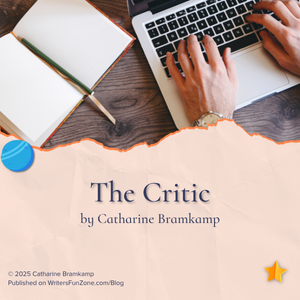 Let’s welcome back monthly columnist Catharine Bramkamp as she shares with us “The Critic.” Enjoy!
Let’s welcome back monthly columnist Catharine Bramkamp as she shares with us “The Critic.” Enjoy!
***
Encountering the CriticWe have all encountered the Critic.
Of course, good criticism is very beneficial. We need to know how to improve our work and understand if it’s working for the reader.
But it’s too easy for criticism to descend into toxicity.
For the truth is: writers are timid — Critics are confident. Artists are built from doubt — Critics are certain.
Critics love nothing better than to inform you of a typo in your handout or errors in your published book. (In a client’s book set in 1876, a critic pointed out that barbed wire wasn’t invented until 1879.)
The Sensitivity of CreatorsCritics can be so righteous and terrifying that sensitive artists will simply stop making anything just to avoid confronting the self-satisfied censor and his negative comments.
We will work over an essay or a painting until holes are worn in the canvas and book chapters lose all color and light because we are so afraid of the Critic, of making a mistake.
That protection comes at a high cost. Our art is at stake, but how can artists cope when the entire internet is crawling with critics? Or Trolls.
My Encounter With the CriticI was asked to create a class with very little turnaround time. At the class, one of the students arrived and the first thing she announced was she found a typo in the handout, the winner in a contest I didn’t know I had entered.
I thanked her for her effort and asked her to send me a list of the mistakes so I could correct them.
She replied, “Oh, there were just too many to count.”
In other words, she had no intention to help, her goal was to publicly announce that she was right, and I was wrong.
I would like to say that this woman came to some appropriately poetic bad end, but I never saw her after that class.
She was left to her fate, and I to mine.
The Difference Between Doing and JudgingI believe that:
“It is not the critic who counts; not the man who points out how the strong man stumbles, or where the doer of deeds could have done them better . . . credit belongs to the man who is actually in the arena, whose face is marred by dust and sweat and blood. . .”
[Editor’s note: Quote from Man in the Arena by Theodore Roosevelt]
What I have found is that those who sail, face storms, and risk wrecking their boats on a rocky shore are kinder to their fellow sailors than those who never wiggled their toes in the tide.
When you understand the effort, know what it takes to create, and appreciate how much nerve you need to present your art or speak to a group, you are far more likely to support rather than criticize.
What Kind of Person Do You Want to Be?And if you are critical just to be right, here is your chance to change.
Do you want to criticize, or do you want to dare greatly?Do you want to find fault or discover marvelous things?Do you want to demoralize, or do you want to inspire?Do you want to experience “the triumph of high achievement? . .”And if not triumph, would you rather fail big “while daring greatly?”
Daring to CreateWhen you write, you are daring greatly.
You are doing, not watching.
You are beginning something that no one else has ever dared begin, let alone see through to the end.
Know that often the Critic is more timid and unempowered than we imagine.
They lash out at us because they aren’t doing anything themselves.
The only sure way to avoid mistakes is to stand still and touch nothing, and they know it.
Question the CriticMy upbringing by cautious, fearful people instilled in me a mindset of “don’t dare,” “don’t overdo,” and “don’t make mistakes.”
The worst messages to burden a creative with.
It took me years to overcome all that discouragement.
But I did.
Most days.
We all make mistakes.
I routinely abuse my friends by asking them to volunteer as beta readers for my books.
They always confirm that I want them to circle any typos, grammar, or historical errors. (Or cooking, a friend pointed out a cooking error, no surprise.)
I confirm, hell yes, and thank you.
Once those mistakes are discovered, I turn the entire work over to my brilliant copy editor, who finds more mistakes.
We try, we make mistakes. We hire editors.
When faced with a scary critic (and they have learned to be scary, many are bullies as well), question their legitimacy.
Is the critic a fellow sailor?Has this critic done what you’ve done?Has he or she written a book?Submitted poems?Daily bled onto the page?Because if not, well. . . .
You Have Already WonIf you create, you have already won.
Your daring and effort guarantee that your “place shall never be with those cold and timid souls who neither know victory nor defeat.”
When a person is busy finding your mistakes, they don’t leave time to make their own. That is a terribly cold place to live.
The Man in the Arena – delivered by Theodore RooseveltIt is not the critic who counts; not the man who points out how the strong man stumbles, or where the doer of deeds could have done them better.
The credit belongs to the man who is actually in the arena, whose face is marred by dust and sweat and blood; who strives valiantly;
who errs, who comes short again and again,
because there is no effort without error and shortcoming;
but who does actually strive to do the deeds; who knows great enthusiasms, the great devotions; who spends himself in a worthy cause;
who at the best knows in the end the triumph of high achievement, and who at the worst, if he fails,
at least fails while daring greatly,
so that his place shall never be with those cold and timid souls
who neither know victory nor defeat.
— Theodore Roosevelt – The Man in the Arena
I need your help! I’m writing a book on creativity, and I need your input. Please take this short survey, and your story may be featured! Thanks! Due September 1, 2025.
***
Want to read more articles like this one Writer’s Fun Zone? Subscribe here.
***
ABOUT THE AUTHOR Catharine Bramkamp is a successful writing coach, Chief Storytelling Officer, former co-producer of Newbie Writers Podcast, and author of a dozen books including the Real Estate Diva Mysteries series, and The Future Girls series. She holds two degrees in English and is an adjunct university professor. After fracturing her wrist, she has figured out there is very little she is able to do with one hand tied behind her back. She delights in inspiring her readers.
Catharine Bramkamp is a successful writing coach, Chief Storytelling Officer, former co-producer of Newbie Writers Podcast, and author of a dozen books including the Real Estate Diva Mysteries series, and The Future Girls series. She holds two degrees in English and is an adjunct university professor. After fracturing her wrist, she has figured out there is very little she is able to do with one hand tied behind her back. She delights in inspiring her readers.
The post The Critic by Catharine Bramkamp appeared first on Writer's Fun Zone.
June 30, 2025
Quick Tips for Writing Your Character’s Identity
Quick Tips for Writing Your Character’s Identity – How To Write the Future podcast, episode 159
***
“Get to know the people, read the history, talk to the people as people. But not as subjects. You’re not a scientist, you’re a novelist. And being a novelist means getting into the heart and mind of your character and their body too.” – Beth Barany
In this How To Write the Future episode, titled “Quick Tips for Writing Your Character’s Identity,” host Beth Barany invites listeners to watch a quirky and interesting intro about the infinite possibilities you can give to your character’s identity. She emphasizes the importance of understanding diverse perspectives, incorporating personal experiences, and using sensory details to create authentic and relatable characters in fiction.
Platforms the podcast is available on: Apple Podcasts | Buzzsprout | Spotify | Amazon Music| YouTube
RESOURCESSupport our work for creatives! Buy me a coffee: https://ko-fi.com/bethbarany
GET HELP WITH YOUR WORLD BUILDING – START HERE
Free World Building Workbook for Fiction Writers: https://writersfunzone.com/blog/world-building-resources/
Sign up for the 30-minute Story Success Clinic with Beth Barany: https://writersfunzone.com/blog/story-success-clinic/
Get support for your fiction writing by a novelist and writing teacher and coach. Schedule an exploratory call here and see if Beth can support you today: https://writersfunzone.com/blog/discovery-call/
About the How To Write the Future podcastThe How To Write The Future podcast is for science fiction and fantasy writers who want to write positive futures and successfully bring those stories out into the marketplace. Hosted by Beth Barany, science fiction novelist and creativity coach for writers. We cover tips for fiction writers.This podcast is for readers too if you’re at all curious about the future of humanity.
This podcast is for you if you have questions like:
– How do I create a believable world for my science fiction story?
– How do I figure out what’s not working if my story feels flat?
– How do I make my story more interesting and alive?
This podcast is for readers, too, if you’re at all curious about the future of humanity.
Transcript for episode 159 Quick Tips for Writing Your Character’s Identity Introduction and HostsBETH BARANY: Hey space and Dragon fans. Beth Barany here with How to Write the Future Podcast. This is a bit of an unusual podcast where I talk about quick tips for writing your character’s identity.
To get the full benefit, watch this podcast on YouTube. And if you enjoy it, please like and subscribe, and share it with a friend or two who would enjoy this wonderful trippy world of being a creative writer.
Enjoy.
Infinite possibilities.
BETH BARANY: When I was a freshman in college, I could stand in my dorm room and look at the mirror on one wall, and behind me was the mirror on the other wall, and this is what I essentially saw. But with my face, of course.
So, yeah, I was, um, staring into the abyss, and honestly, it felt like my first psychedelic experience, even though I have never taken drugs.
BETH BARANY 2: Wait a minute, didn’t you like take a puff of pot once?
BETH BARANY: Uh, barely.
BETH BARANY 2: Yeah. So tell me more about this mirror experience.
BETH BARANY: Um, well, I was 18 years old, you know, freshman at college, away from home. And some kind of understanding happened. It was like I looked into some kind of crazy, some kind of loss of self, loss of identity, loss of everything I understood.
BETH BARANY 2: Wow, that must’ve been disorienting.
BETH BARANY: Yeah, totally, totally disorienting. Totally. Don’t look at me like that.
BETH BARANY 2: Like what?
BETH BARANY: Um, like, like, you get me, like you understand.
BETH BARANY 2: You know what? I, I totally understand. I mean, come on. I’m, I’m a novelist. We novelists, we go all kinds of places.
BETH BARANY: Oh, thanks for understanding. So, what is this podcast really about? Uh, let’s see.
Yeah. Hey, everyone. What is this podcast really about? I think it’s about identity.
Being a writer allows us to go into all kinds of identities, all kinds. What does this mean?
In the age of cultural sensitivity, this means if you are writing from another culture’s perspective, really get to know it. Get to know the people, read the history, talk to the people as people. But not as subjects. You’re not a scientist, you’re a novelist. And being a novelist means getting into the heart and mind of your character and their body too, but I dunno what to say here.
BETH BARANY 2: That’s okay. You don’t have to say anything.
[03:19] Setting the SceneBETH BARANY: Switching gears now. Coming to you from a local wine bar.
It reminds me of Paris.
[03:25] Personal Connection to Paris and French LanguageI lived in Paris twice and I learned French when I was 16. French is a more emotional language than English in my opinion. Therefore, speaking French brings out this more emotional part of me. And maybe that’s why I also include lots of, allusions to French language in my fiction because it allows me to connect to that more emotional part of me.
[03:52] Incorporating Personal Experiences into FictionNow, when you think of different locations that you loved and you bring them into your fiction, you are bringing those parts of you, you could say those parts of your identity, into your fiction.
Have you ever had the experience of watching a TV show or a film or reading a book where you feel completely like you’re the other person?
It’s hard to say exactly what caused that in you, but as a writer, you can learn how to be more intentional and help your readers step into that other identity.
[04:27] Understanding and Creating Character IdentitiesAnd part of that comes from you creating the associations that go along with your character, how they feel about their setting, how they feel about the people around them, their attitudes, their beliefs.
All these things go to form our identities.
Now, do we have multiple identities? We probably have a core identity that is steady throughout our lives, but that evolves and changes and grows. But you might be able to find threads of it or like the core of it from when you were a child.
And now, as you write that part of you that is indelibly you is probably throughout all the stories that you write, but the characters that you create can reflect different beliefs and worldviews that are going to convey a completely different identity.
What’s amazing about being human is we actually can sense into this, into other people, and this allows us to convey it in our art.
[05:32] Invitation to Explore Different IdentitiesSo here’s my invitation to you. Go ahead and pretend to be somebody else. Oh, wait, you probably already do that as a novelist.
But really puts some attention on what is their attitude and belief and worldview, and how can you convey that through how they talk and move about their environment, how they think about their environment.
[05:57] Sensory Details and Their Impact on WritingI’m gonna be in Paris by the time you listen to this episode, and when I’m there I notice I am more into the sensory details of life, more sensual, just in the basic food and drink way. French love their food and drink, so when I’m there, I get to really enjoy it, maybe even more than I do when I’m back home in the United States.
So all that to say, where do you feel the most alive?
What sensory details can you bring into your character’s perspective that really bring their worldview, their attitude, and beliefs alive?
[06:35] Conclusion and Final ThoughtsAlright, that’s it for this week, everyone. I hope you enjoyed this different episode.
Let me know in the comments what you think of it, and write long and prosper.
Loved this episode? Leave us a review and rating here: https://www.buzzsprout.com/2012061Need instructions on how to leave a review? Go here.
***Support our work for creatives: leave a tip: https://ko-fi.com/bethbarany
***
ABOUT BETH BARANYBeth Barany teaches science fiction and fantasy novelists how to write, edit, and publish their books as a coach, teacher, consultant, and developmental editor. She’s an award-winning fantasy and science fiction novelist and runs the podcast, “How To Write The Future.”
Learn more about Beth Barany at these sites:
Author site / Coaching site / School of Fiction / Writer’s Fun Zone blog
CONNECTContact Beth: https://writersfunzone.com/blog/podcast/#tve-jump-185b4422580
Email: beth@bethbarany.com
LinkedIn:https://www.linkedin.com/in/bethbarany/
IG: https://www.instagram.com/bethbarany/
TT: https://www.tiktok.com/@bethbarany/
FB: https://www.facebook.com/bethbarany
X: https://twitter.com/BethBarany
CREDITSEDITED WITH DESCRIPT: https://www.descript.com?lmref=_w1WCA (Refer-a-Friend link)MUSIC CREDITS : Music from Uppbeat (free for Creators!): https://uppbeat.io/t/soundroll/fuzz-buzz License code: UMMKDRL02DFGKJ0L. “Fuzz buzz” by Soundroll. Commercial license: https://musicvine.com/track/soundroll/fuzz-buzz.DISTRIBUTED BY BUZZSPROUT: https://www.buzzsprout.com/?referrer_id=1994465 (Refer-a-Friend link)SHOW PRODUCTION BY Beth BaranySHOW CO-PRODUCTION + NOTES by Kerry-Ann McDadec 2025 BETH BARANY
For more “How To Write the Future” episodes, go here.
If you’d like to invite Beth onto your podcast, drop her a note here.
 Like the work we do? Tip us! https://ko-fi.com/bethbarany
Like the work we do? Tip us! https://ko-fi.com/bethbarany
The post Quick Tips for Writing Your Character’s Identity appeared first on Writer's Fun Zone.
June 27, 2025
Tiny Experiments: A Review and Interview with Anne-Laure Le Cunff by LA Bourgeois
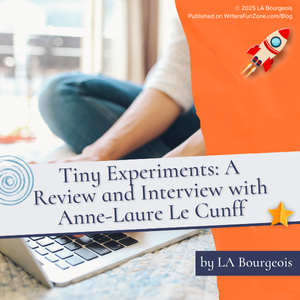 Let’s welcome back LA Bourgeois as she shares with us “Tiny Experiments: A Review and Interview with Anne-Laure Le Cunff.” Enjoy!
Let’s welcome back LA Bourgeois as she shares with us “Tiny Experiments: A Review and Interview with Anne-Laure Le Cunff.” Enjoy!
***
Books for Thriving Creatives in 2025During 2025, we’re reading Books for Thriving Creatives , and LA Bourgeois reviews them for us! Chosen texts covered integrating humor into your writing , reframing your money mindset , choosing your life purpose , and the writing business . Have a suggestion for a book to read or want to go deeper? Join her at The Thriving Creative for bonus content!
Meet Anne-Laure Le Cunff: Author and Founder of Ness LabsAs a child, Anne-Laure Le Cunff, author of Tiny Experiments and founder of Ness Labs, dreamed of a life filled with curiosity and adventure.
“I wanted to be so many things: a paleontologist, a fantasy writer, a veterinarian, a politician,” she said. “I even imagined doing steeplechase.”
Tiny Experiments: What it isThat theme carries through Tiny Experiments as Le Cunff encourages the reader to set aside the idea of linear goals and instead focus on growth loops, creating experiments from our curiosities whose results can be tracked and used to form the next steps.
As she says, “We don’t go in circles; we grow in circles.”
Creating Your Pact With Small StakesExperiments begin with creating a pact, a simple phrase that states “I will [action] for [duration].”
By keeping the stakes small, a person frees themselves to learn more about their project and make progress toward a finish.
Le Cunff says, “It’s almost impossible to fail when you see everything as an experiment.”
Reframing Progress and DecisionsThe evaluation process is as important as the pact itself.
Le Cunff reframes many of the usual tools to track progress as useless and suggests alternatives.
For example, she reveals the fallacy of the pros-and-cons list in a surprising way, saying, “Such lists can provide plausible-sounding but hollow reasons to pursue choices that do not reflect your authentic needs and desires.”
Instead, she recommends practicing decision framing, a technique that expands your view to include both external information and internal instincts to inform the final choice.
As an example, in deciding to write your next story, you would consider not just the external possibilities of saleability and technique improvement, but also the pleasure of writing a story that speaks to your heart.
Practical Tools for Result TrackingThis book describes a process that is easy to follow with tools that make your experiments repeatable.
For instance, during your experiments, she encourages you to take “Field Notes,” quick notations of reactions or ideas, to track the results of the current project.
Outcome is Not Important: Focus on ActionAnd the best part is that your focus remains on your actions instead of outside metrics to evaluate, ie. choose to say “I will write for fifteen minutes every day-ish” rather than “I will publish my book this year.”
This one change releases you from the tyranny of external “success.” Rather, every completed tiny experiment is a closed loop, a project that you can point to and say, “Finished! Success!”
As Le Cunff says, “Success is the lifelong experiment of discovering what makes you feel most alive.”
By following the techniques and tools described in Tiny Experiments, you may find yourself surprised at exactly what that thing that makes you feel the most alive turns out to be.
A Conversation with Anne-Laure Le CunffLe Cunff’s curiosity and playfulness shone through every interaction I had with her.
Enjoy our short interview where she shared her inspiration for Tiny Experiments, the most effective tool in the book, and what being a thriving creative means to her.
What specific event prompted you to begin Ness Labs?
I hit a point in my career where I felt completely lost. So I went back to the drawing board and asked myself: What am I genuinely curious about? I had always been fascinated by the brain and how we think, feel, and experience the world, so I decided to retrain as a neuroscientist.
To make sense of what I was learning, I started a weekly newsletter. That newsletter became the seed that grew into Ness Labs: a learning community, a series of courses, and a book.
How did you decide to focus on tiny experiments for this book?
As I reflected on all the research, writing, and teaching I’d done, I noticed a unifying thread: the value of trying things out and learning from them.
The idea of experimentation kept surfacing.
Tiny experiments take the pressure off while encouraging sense-making.
That’s how the concept emerged as the heart of the book: a more liberating approach to ambition and personal growth.
Many of my readers struggle with uncertainty. What do you consider the magic of the liminal space?
Liminal spaces are deeply uncomfortable, so we normally want out as fast as possible.
But they’re also where the most profound growth can happen. If we can resist the urge to escape and instead stay with the uncertainty, we open ourselves to transformation.
These in-between moments, though unclear, can become powerful turning points if we let them.
Which tool from Tiny Experiments do you consider the most powerful, and why?
The most powerful tool is the Plus Minus Next review.
It’s simple, but transformative. You look at what worked (+), what didn’t (–), and what you want to try next (→).
It helps you celebrate wins, face failures with self-compassion, and maintain momentum, creating ongoing cycles of learning and iteration, which I call growth loops.
How do you define a Thriving Creative?
Someone who’s always willing to experiment, learn from each trial, and iterate.
Not with the certainty of knowing what success will look like, but with the confidence that they’ll figure out their version of success.
Grab a copy of Tiny Experiments: How to Live Freely in a Goal-Obsessed World by Anne-Laure Le Cunff at your favorite indie bookshop, library, or online .
Our next Book for Thriving Creatives is perfect for the height of the summer heat! How to Do Nothing: Resisting the Attention Economy by Jenny Odell encourages and teaches us how to reframe our lives to drop out of the cycle of 24/7 productivity and the trap of addictive technology designed to obtain and sell our attention. Join me for what I hope is a freeling meditation on our real value in this world. You can pick up this book online , at your favorite bookstore or at the library.
***
ABOUT LA BOURGEOIS LA (as in tra-la-la) Bourgeois is a Kaizen-Muse Certified Creativity Coach and author who helps clients embrace the joy of their creative work and thrive while doing it.
LA (as in tra-la-la) Bourgeois is a Kaizen-Muse Certified Creativity Coach and author who helps clients embrace the joy of their creative work and thrive while doing it.
Get more of her creativity ideas and techniques by subscribing to her newsletter at https://subscribepage.io/unlockyourcreativity.
The post Tiny Experiments: A Review and Interview with Anne-Laure Le Cunff by LA Bourgeois appeared first on Writer's Fun Zone.
June 24, 2025
3 Copyright Myths by Kelley Way
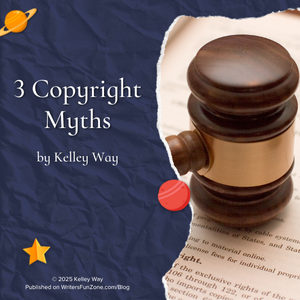 Let’s welcome back monthly columnist Kelley Way as she shares with us “3 Copyright Myths.” Enjoy!
Let’s welcome back monthly columnist Kelley Way as she shares with us “3 Copyright Myths.” Enjoy!
***
There are many misconceptions about copyright law, and there are a lot of copyright myths out there about how they work. Here are just a few that have been floating around for a while:
1. I can get a copyright by mailing a copy of my work to myselfThis is one of the copyright myths I hear a lot about, and it is referred to as “the poor man’s copyright.”
This myth has been floating around for quite some time. But there is no basis to it under copyright law.
Under the current Copyright Act, you have a copyright as soon as your work is down on paper (or typed up, or otherwise “fixed” so other people can look at it).
Registration is beneficial, but it’s not required to actually have a copyright (another commonly held myth). So, the myth is busted — mailing a copy to yourself does not provide any legal benefit.
That said, if you need to prove that your work existed at a certain time in a specific format (e.g. you’re being sued for infringement and need to show your work predated the one you’re accused of infringing), then an unopened, mailed envelope containing your manuscript can prove useful.
2. It’s okay to use someone else’s work as long as I give creditThis one comes up frequently when I give presentations on copyright law.
People think that, as long as they cite their source, they don’t have to get permission.
Unfortunately, that’s not true.
They are confusing copyright infringement with plagiarism.
Plagiarism is taking someone else’s work or ideas and passing them off as your own. Plagiarism is not punishable by law, though it can hurt your reputation and have serious repercussions if you’re in academia.
Copyright infringement is using someone’s work without permission — whether or not credit was given is irrelevant.
So, does that mean you shouldn’t cite your sources?
There are pros and cons either way, but I believe citing your sources is the better way to go from an ethical perspective.
Just bear in mind that you still need permission or a good fair-use argument to proceed.
3. I can revoke a license or terminate a contract anytime I wantIt would be nice if this were true, but unfortunately, it is not.
If you signed a formal contract, you are bound by the terms of that contract, and you can only terminate it if the contract says you can.
If the license was not part of a formal contract, you have a bit more leeway, but you are still limited by laws regarding licenses and contracts, and the licensee also has some rights if they started using the copyright before you terminated the license.
I always recommend putting an agreement in writing, and making sure there’s an “out” clause if you become unhappy with the arrangement down the road.
Conclusion and About the AuthorThese are just a few of the copyright myths floating around. If you have questions about copyright law, or just want to make sure you understand it enough to stay out of trouble, you are welcome to email me at kaway@kawaylaw.com.
***
Want to read more articles like this one Writer’s Fun Zone? Subscribe here.
***
ABOUT THE AUTHORKelley Way was born and raised in Walnut Creek, California. She graduated from UC Davis with a B.A. in English, followed by a Juris Doctorate. Kelley is a member of the California Bar, and an aspiring writer of young adult fantasy novels. More information at kawaylaw.com.
The post 3 Copyright Myths by Kelley Way appeared first on Writer's Fun Zone.
June 23, 2025
Writing Science Fiction for Social Impact
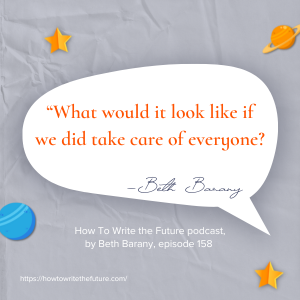
Writing Science Fiction for Social Impact – How To Write the Future podcast, episode 158
***
“What would it look like if we did take care of everyone?” – Beth Barany
In this episode of “How To Write the Future” podcast, authors and writing teachers, Beth Barany and her husband Ezra Barany, explore how speculative fiction can highlight social issues. They discuss strategies for crafting compelling stories that inspire social change without being preachy, while emphasizing the importance of world-building and creating positive narratives.
Platforms the podcast is available on: Apple Podcasts | Buzzsprout | Spotify | Amazon Music| YouTube
RESOURCESSupport our work for creatives! Buy me a coffee: https://ko-fi.com/bethbarany
GET HELP WITH YOUR WORLD BUILDING – START HERE
Free World Building Workbook for Fiction Writers: https://writersfunzone.com/blog/world-building-resources/
Sign up for the 30-minute Story Success Clinic with Beth Barany: https://writersfunzone.com/blog/story-success-clinic/
Get support for your fiction writing by a novelist and writing teacher and coach. Schedule an exploratory call here and see if Beth can support you today: https://writersfunzone.com/blog/discovery-call/
About the How To Write the Future podcastThe How To Write The Future podcast is for science fiction and fantasy writers who want to write positive futures and successfully bring those stories out into the marketplace. Hosted by Beth Barany, science fiction novelist and creativity coach for writers. We cover tips for fiction writers.This podcast is for readers too if you’re at all curious about the future of humanity.
This podcast is for you if you have questions like:
– How do I create a believable world for my science fiction story?
– How do I figure out what’s not working if my story feels flat?
– How do I make my story more interesting and alive?
This podcast is for readers, too, if you’re at all curious about the future of humanity.
ABOUT EZRA BARANY Ezra Barany loves riveting readers with thrillers, but by order of the Department of Motor Vehicles he must place a warning on every book cover, “Do not read while driving.” His first two books in The Torah Codes series were award-winning international bestsellers. The second two books in the 4-book series wowed readers too! In his free time, he has eye-opening discussions on the art of writing novels with his wife and book coach Beth Barany. A high school physics teacher, Ezra lives in Oakland with his beloved wife and two cats working on the next book in The Torah Codes series. Ezra, not the cats. For a free short story in The Torah Codes series, “The Mourner’s Kaddish,” do please go to http://www.thetorahcodes.com/.
Ezra Barany loves riveting readers with thrillers, but by order of the Department of Motor Vehicles he must place a warning on every book cover, “Do not read while driving.” His first two books in The Torah Codes series were award-winning international bestsellers. The second two books in the 4-book series wowed readers too! In his free time, he has eye-opening discussions on the art of writing novels with his wife and book coach Beth Barany. A high school physics teacher, Ezra lives in Oakland with his beloved wife and two cats working on the next book in The Torah Codes series. Ezra, not the cats. For a free short story in The Torah Codes series, “The Mourner’s Kaddish,” do please go to http://www.thetorahcodes.com/.
Transcript for episode 158 Writing Science Fiction for Social Impact Introduction and Hosts
BETH BARANY: Hey everyone. Beth Barany here for How to Write The Future Podcast. I am your host, and today with me I have my husband, Ezra Barany. We are both writers. I am a creativity coach for writers and an award-winning novelist in science fiction and fantasy. And I help writers go from seedling of an idea all the way to publication and my specialty is science fiction and fantasy.
[00:25] The Power of Speculative FictionBETH BARANY: Today we’re gonna talk about writing speculative fiction for social change. Ezra’s got some great questions for me, and if you have a question, be sure to ask it in the comments at how to write the future.com or tag me on social media.
If you would like more support around your world building for your science fiction or fantasy novel, be sure to stay to the end and I’ll tell you how to get some more help.
All right. That’s it. Yeah. Take it away Ezra.
EZRA BARANY: Great. So you know how like most politicians, they get up out of bed and they say, today, I want to emulate Wally because that’s, that’s who they want to be.
[01:09] Influence of Science Fiction on SocietyEZRA BARANY: How can these science fiction and fantasy narratives rewrite, effectively influence policy makers and social movements?
BETH BARANY: Like Wally? like Wally? Uh, I, I don’t, I don’t know if the message got across exactly. I honestly don’t know except only in retrospect do we see science fiction and fantasy stories, especially science fiction, having an impact. And Star Trek. Star Trek’s the best example.
EZRA BARANY: Yeah.
BETH BARANY: People who watch Star Trek as children and then later on became scientists and tech folks. And, they talk about how, what was shown on the screen there drove them. They’re like, ah, I wanna make a tri-quarter. Oh my gosh, transporter. How could that work? Warp speed. How could that work? We don’t know when we create it.
When they were creating the show, they were saying, let’s change society. Let’s make a Western in space. Yeah.
EZRA BARANY: Great. That actually does lead into the next question.
[02:08] Using Speculative Fiction to Address Social IssuesEZRA BARANY: How can writers effectively use speculative fiction to highlight current social issues?
BETH BARANY: Yes.
EZRA BARANY: Because what you were talking about was more tech stuff.
BETH BARANY: Yeah.
EZRA BARANY: But now talking about social issues.
BETH BARANY: Yeah. Oh my gosh.
EZRA BARANY: Current ones.
BETH BARANY: Current. Yeah. Science fiction is great for this. In fact, I would say that science fiction is a wonderful lens to use to highlight social issues.
And coming back to Star Trek, just ’cause it’s so handy, you know there’s an interracial kiss in the story. We have a black woman played by Nichelle, Nichelle Nichols. She is not a maid or a singer or someone’s girlfriend. She has a full on role in the show.
So the values of the creator, Gene Roddenberry created Star Trek and many people have taken those ideas and brought them forward into the current franchise. So, he had values where all people are included, all people have value. Let’s put people of, all kinds of people, so you have characters who weren’t being portrayed in the media as having full roles with interesting things to do and say, and had an active role in the plot. And here Gene Roddenberry put them in these active roles.
That’s so awesome.
EZRA BARANY: Yeah.
BETH BARANY: So.
EZRA BARANY: Well there was one episode where there are two people, so there’s one whose on right side of their face was white, their left side of the face was black and they were calling the other people lower class or not worthy because they were black on the right hand side and white on the left hand side.
And it really brought out the social justice issue of the time.
BETH BARANY: Yeah, absolutely. And, one of Elizabeth Moon’s books has the technology of longevity, and I’m actually playing with this as well, in my upcoming story. But what happens when you have a society where people can live longer and longer, and so people are staying in power who are older and older. That creates a problem for the younger generation. When do they get to take the reins of power? And now you’ve got some older ideas, enmeshed ideas that don’t get to cycle out and no room for new ideas, new people, and new ideas. Elizabeth Moon is a contemporary writer and she’s been writing about these, one of those, that issue, I think those books came out in the eighties.
We still have that problem, right? Of older leaders in the world not making room for new, younger generation. And I know you wrote a story about a society where everyone was expected to wear beige clothing and then one woman wanted to express her individuality by painting and bringing in bright colors and how that was…
EZRA BARANY: Taboo.
BETH BARANY: That was taboo. So that’s a great commentary. If everyone is only supposed to be dressing the same, acting the same, then where’s the room for individuality?
[05:01] World Building for Social ChangeEZRA BARANY: And that kinda leads into the next question, which is how does world building contribute to drive social change?
BETH BARANY: Huge. There’s a famous book called Utopia, written back in the 16th century, and that really started the movement around people thinking about utopias and writing about them and trying to create them in real life. And this is also a theme that I realized I’m trying to build a utopia on one of my space stations in my current work in progress, the next Janey novel.
And knowing that, it was like, oh, okay, I’m gonna have a builder who had this aspiration, and then we get to see how it plays out. By the time my main character’s there, it’ll be 70 years plus from the origin of that station. So she gets to see, oh, this was built with all these values to have kind of a utopia, but here’s what’s actually working or not working.
So knowing the broader, I guess, worldview of the people who create the societies that you’re building for your story is gonna help you understand, knowing why was a community created and then how, what are the consequences of that in real time for your main character.
EZRA BARANY: Going back to my story, it was all about gender neutrality, and so there were colors that were too feminine and colors that were too masculine. And so they said, you know what? Let’s just everyone wear beige so that everyone’s equal. And this woman just wanted to express herself in her femininity and used colors in her paintings and the like. So that defined the direction of what this character was going through, and the results and challenges of such a world.
BETH BARANY: And that also brought up the social issue of conformity versus non-conformity. Group versus individual. Yeah. Really great topics, and I just wanna say, science fiction is a great place to explore the social issues and to push the boundaries of what we could be.
And I know a lot of people write dystopia. And a lot of people wanna watch dystopia, but my premise is: why don’t we also use our imagination to imagine the better parts of humanity? What would it look like if we did take care of everyone? What would it look like if instead of gender neutrality, what if all flavors could exist? What if,simply put, what if male and female colors, well, that didn’t exist? And people are people.
What are the ramifications and how do people handle that? And of course, you’re gonna still have conflict because I think conflict is just part of life. But science fiction allows us to, especially science fiction, but fantasy can do this too, to explore different dynamics, different power dynamics, different group dynamics, and different ways of parceling out the goods that we all need to survive.
EZRA BARANY: Nice. Last question.
[07:49] Strategies for Non-Preachy Social MessagesEZRA BARANY: So what strategies can writers use to make their social messages resonate without being preachy?
BETH BARANY: Yes. So this is something that you and I have talked about this great technique of thesis, antithesis, synthesis. Maybe in your story you wanna bring in this idea of gender equality.
Let’s just pull something outta the air that is also happening around us. So maybe your main character thinks that the way the genders are treated is just fine, but maybe you have another character in your story who’s advocating for gender equality, that doesn’t quite exist in your story world.
Now you put these two characters together, one who thinks it’s just fine, and the other who’s like advocating for change. You put them together, and you create a reason why they have to be together. Yes. I am thinking of romance. Because this is often done in romance where you create a way that the two love interests have to be together. They have to solve an external problem and in the process learn each other’s perspective, and by the end, maybe they come to a nuanced understanding.
It’s not all black or it’s not all white, but there’s actually a nuanced understanding and that’s what the synthesis is.
You want to give your character a point of view and you want to give characters around them other points of view. And it might not just be two, it might be three or four or five different points of view on the topic. And then you want to make your central challenge in the story deal with that issue so that everyone gets to chime in.
And it’s not a simple issue that’s being dealt with in the story. And that by the end, you have your protagonist, ideally who has gone through some kind of transformation, and also the secondary character, if you are doing a romance, it’s great if both characters get to have a transformation.
So now you’ve taken this idea of the way things should be, and now it’s not the way things should be, it’s a lived experience for your character from A to Z and same for your secondary characters and tertiary characters even. And maybe the society or environment or town. Everybody gets an opportunity to shift and grow and transform in some way.
And now it’s not an idea. It’s a lived experience that has real consequences for your characters and for their surrounds and their environment.
EZRA BARANY: There was one book I wrote that was asking the question that perhaps the main character was wondering, he might have asked himself: What do women want?
And throughout the book there were women of different wants and different goals and different desires. And so at the end he has this conclusion. And originally I had three pages where he reflects on everything he experienced and learned from it, and I realized that was preachy, so I cut it down to just two sentences or three sentences, something like that.
And, I remember getting a review saying, oh, thank goodness you came to this conclusion without just shoving it down readers’ throats. And it just said it simply. yeah, it’s good to..
BETH BARANY: That’s great.
EZRA BARANY: Do it that way.
BETH BARANY: Yeah. So one or two sentences where they realize, oh, I used to think this but now I realize that.Or even just the realization and if it comes out as very natural and in their natural thoughts or in dialogue is actually better, that, that’s so powerful.
EZRA BARANY: That’s great.
BETH BARANY: Yeah. Good, good.
[11:01] Conclusion and Call to ActionBETH BARANY: If you would like more support around writing your speculative fiction, science fiction, or fantasy, or some wonderful mashup of that, and especially help with your world building, then be sure to check out our World Building Workbook for fiction writers. It’s a PDF that will help you work through, it’s a workbook, all the different aspects of your story world. And if you have any questions, be sure to contact me at Beth Barany on any of the social channels or you can write me at how to write the future.com.
You can even leave me a voicemail. Which no one has done yet, so be the first.
EZRA BARANY: This is the finger wagging moment.
BETH BARANY: The finger wagging moment. This is episode 158 and no one has left me a 30 to 60 second voice message. You could be the first.
EZRA BARANY: Yay.
BETH BARANY: Yay. Alright. This has been fun. We’ve done three episodes in this little series. Ezra and I. I’ll have to have him back for another series at some later date, or if you have a special topic for him, we can put him in the hot seat and have him do an episode.
EZRA BARANY: Let me just..
BETH BARANY: Yes.
EZRA BARANY: What can people get? The first person who sends a voice message what’s, what will you commit to right now as a free gift?
BETH BARANY: You can get if you leave me, oh, that’s really great, incentive.
Incentive. If you leave me a voice message through how to write the future.com and you’re the first person you get to have any book of your choice from my catalog.
EZRA BARANY: Sweet
BETH BARANY: Or Ezra’s catalog. And either digital or signed, we will ship it to you ’cause I love to do that.
EZRA BARANY: That’s fun.
BETH BARANY: With a bookmark, ’cause we have bookmarks first.
EZRA BARANY: You’re welcome.
BETH BARANY: You’re welcome. Ezra, oh my God, oh my God. Alright, this episode is long enough. Do you wanna say our line that we say at the end?
EZRA BARANY: Happy birthday.
BETH BARANY: That’s not it.
EZRA BARANY: That’s, that’s, no, you do it because you’re the best.
BETH BARANY: Oh, okay. I’m the best. All right. In honor of Star Trek and something that I say at the end of every episode. Write long and prosper.
Loved this episode? Leave us a review and rating here: https://www.buzzsprout.com/2012061Need instructions on how to leave a review? Go here.
***Support our work for creatives: leave a tip: https://ko-fi.com/bethbarany
***
ABOUT BETH BARANYBeth Barany teaches science fiction and fantasy novelists how to write, edit, and publish their books as a coach, teacher, consultant, and developmental editor. She’s an award-winning fantasy and science fiction novelist and runs the podcast, “How To Write The Future.”
Learn more about Beth Barany at these sites:
Author site / Coaching site / School of Fiction / Writer’s Fun Zone blog
CONNECTContact Beth: https://writersfunzone.com/blog/podcast/#tve-jump-185b4422580
Email: beth@bethbarany.com
LinkedIn:https://www.linkedin.com/in/bethbarany/
IG: https://www.instagram.com/bethbarany/
TT: https://www.tiktok.com/@bethbarany/
FB: https://www.facebook.com/bethbarany
X: https://twitter.com/BethBarany
CREDITSEDITED WITH DESCRIPT: https://www.descript.com?lmref=_w1WCA (Refer-a-Friend link)MUSIC CREDITS : Music from Uppbeat (free for Creators!): https://uppbeat.io/t/soundroll/fuzz-buzz License code: UMMKDRL02DFGKJ0L. “Fuzz buzz” by Soundroll. Commercial license: https://musicvine.com/track/soundroll/fuzz-buzz.DISTRIBUTED BY BUZZSPROUT: https://www.buzzsprout.com/?referrer_id=1994465 (Refer-a-Friend link)SHOW PRODUCTION BY Beth BaranySHOW CO-PRODUCTION + NOTES by Kerry-Ann McDadec 2025 BETH BARANY
For more “How To Write the Future” episodes, go here.
If you’d like to invite Beth onto your podcast, drop her a note here.
 Like the work we do? Tip us! https://ko-fi.com/bethbarany
Like the work we do? Tip us! https://ko-fi.com/bethbarany
The post Writing Science Fiction for Social Impact appeared first on Writer's Fun Zone.

